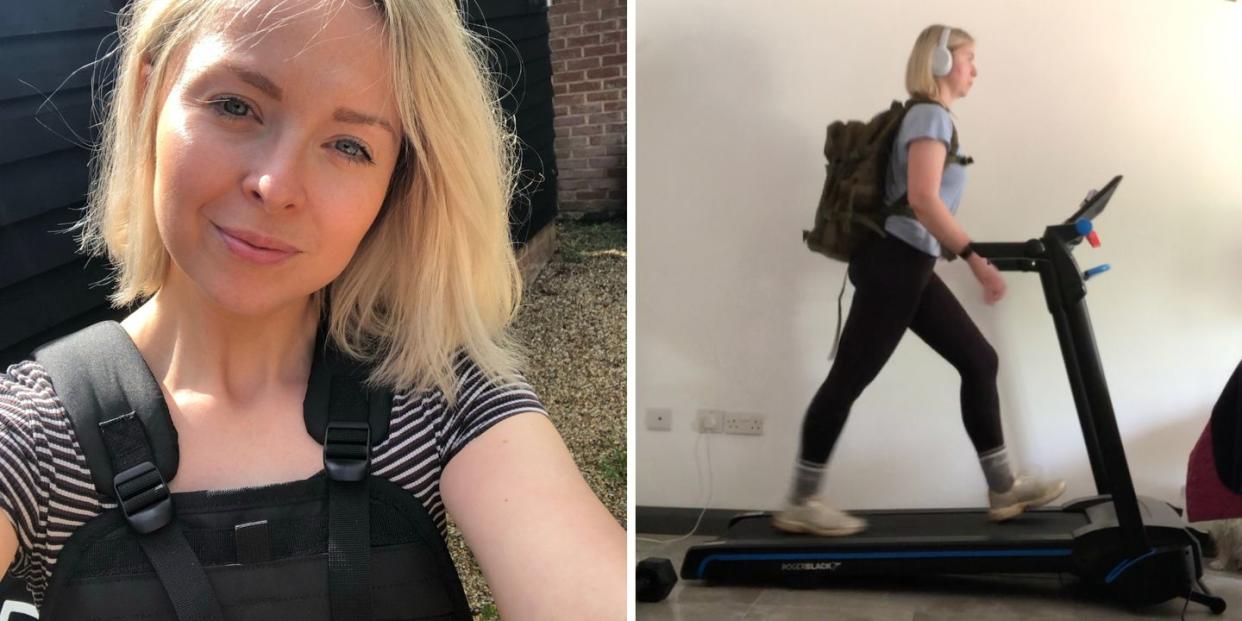'I upgraded my walks with a weighted vest for a week - here's what happened'

It seems everywhere we look on our social feeds, everyone is donning a weighted vest or packing their rucksacks for their walks in pursuit of a low(er) form of exercise intensity. It turns out that whether you prefer to don a rucksack (see: ‘rucking’) or walk in a weighted vest, semantics aside, carrying things over long distances is a killer move for upgrading our cardio efforts. Acutely aware of these benefits, I was keen to suit up my daily walks for a one week challenge.
In fact, this wasn’t the first time I’ve built loaded carries into my daily routine. For years I would carry heavy equipment up a steep hill for a 15 minute hike to reach an outdoor training spot for my personal training clients. In doing so, I’d inadvertently received the rewards of feeling the fittest and strongest I’d ever been. Something I have greatly missed now that the commute to my desk is particularly light in comparison.
Author of The Comfort Crisis, Michael Easter is also a strong proponent for rucking or walking in a weighted vest, especially for women, and believes it is the solution for the modern day dilemma of a chronic sedentary lifestyle. In Easter's 2% newsletter he explains: 'The human body is built to ruck, to carry weight over distance.’
It's something that humans through the ages have naturally taken to, explains Easter, ‘We’re the only animals that can carry stuff far. As we evolved, we’d use this skill to hunt and gather, move resources, and bring tools into the unknown.'
An area of increasingly more interest, Easter adds that more and more health scientists are realising that rucking might be the best exercise for women. 'That’s because rucking gives women unique benefits that other exercises don’t,’ says Easter.

Why should women walk in a weighted vest?
Gym-free weight training
We get it. We need to be resistance training, and we are increasingly aware of this need to resistance train as we get older. And if we don't quite fancy heading to our gym during rush hour, walking in a weighted vest allows us to improve our strength without stepping foot in a weight room.
One of the most appealing benefits of walking in a weighted vest, is that we can do it in our local park while getting some fresh air. And with UK movement guidelines recommending 150 minutes of moderate exercise a week, walking in a weighted vest can help us effectively tick that box. ‘Rucking combines endurance and strength. It allows women to meet [exercise] guidelines and work their muscles without setting foot in a weight room.’ says Easter.
Cardio, but make it low impact
By bearing more weight and covering the same ground, we increase our heart rate and the intensity of the movement we carry out, without the higher impact of jumping or running. In a study on women conducted by the University of New Mexico, it found that using a weighted vest can increase VO2 max when including slow treadmill walking. So slinging on a weighted vest can be an easy way to get our cardio in, without the treadmill.
Improved bone density
A study published by Quality of Life Research found that when older participants took part in exercise in a weighted vest, they increased bone density by 1% in comparison to the group who didn’t wear a weighted vest, whose bone density decreased by 0.6% over the course of the investigation.
According to Easter, ‘Everyone starts losing bone density around age 30. But women after menopause begin losing it at a rapid and dangerous rate. This is why bone fractures are one of the biggest health threats to women.’
And a way we can prevent this decline in bone density, is by adding some weight to our walks. Another study published by The Journals of Gerontology found that when investigating the effects of exercise with a weighted vest on postmenopausal women, hip bone density loss was prevented and bone mineral density was maintained. Not only this, long term commitment to the exercise programme was adhered to for over five years, meaning it was perhaps an easy and enjoyable addition to their routine.
Higher exercise exertion
It seems that the rumours about us tolerating discomfort in exercise are true. Easter explains that women tend to push themselves harder during exercise such as rucking or walking in a weighted vest, and references a study on British military recruits, 'The recruits had to ruck six miles with either 33 or 44 pounds. The weights weren’t split by sex, meaning some women rucked with 44 pounds,' says Easter.
'The women completed the course an average of two minutes faster than the men. Because of this effort, the women reported a higher rate of perceived exertion (basically how hard the ruck felt) compared to men, yet they were better able to push through the discomfort. This is a finding that’s been repeated in other research. Women have a high exercise discomfort tolerance.'
These weren't the only findings explains Easter, 'The women also recovered their fitness faster. When they retested the men on a marker of leg strength, their performance had plummeted. Meanwhile, the women’s strength hadn’t dropped all that much.'
It seems that walking in a weighted vest, or rucking, could be a hidden talent of ours, waiting to be tapped into.
What muscles does walking with a weight vest work?
Walking in a weighted vest predominantly works your lower body muscles, so your quadriceps, hamstrings, glutes and calf muscles. But also your core, trapezius and trunk stabilising muscles while you try to stay upright. With a rucksack filled with weights, you’ll find yourself contracting your abdominal muscles to avoid it pulling you back. Whereas a vest is weighted proportionately around the body, therefore working the back and abdominal muscles more equally.
To make sure I made the most out of walking in a weighted vest and was working the right muscles, I focused on:
Keeping an open chest with my eye line up and ahead
Having even strides to ensure I was being economical with my movement
Either holding onto the handles of the rucksack or letting my arms swing loosely at my sides
Engaging my core when fatigue increased to avoid slouching
5 things I learned from a week of walking in a weighted vest
1/ It was surprisingly more intense than I expected
Recommendations are to start rucking or walking in a weighted vest with 10-15% of bodyweight; I had optimistically opted for the higher end of this scale and decided to use 10kg. On my first day, I set out for 30 minutes on the treadmill at my usual pace, but found after 10 minutes I needed to lower the speed a little. I even debated taking some weight out, however I eventually got into the swing of it. 30 minutes at a brisk pace was certainly enough to get a good sweat on.
2/ I prefer walking in a weighted rucksack vs a weighted vest
A personal preference, I like to position the weight behind me in a rucksack. This means my trap muscles (the muscles either side of my neck) don’t have to work so hard and aren’t so achey when walking for longer distances. However, a weighted vest is a little more practical to fit under a coat or hoodie for short walks around the block or dog walks. To use a rucksack instead, you can take the weights out of your weight vest and pop them in your rucksack, just make sure the straps are fitted tightly and comfortably.
3/ My walking heart rate was much higher than usual
Anyone who regularly walks their dog will be familiar with patiently stopping on a regular basis while they sniff, and will know it’s hard to get your heart rate up for a sustained period. The benefit of having a weighted vest on, is that during the periods of walking at a brisk pace, you can increase your heart rate more, even if you do need to stop here and there.
4/ You can increase the weight and duration gradually
It doesn’t have to be super intense. In fact, you can start with a weight you feel is manageable and add 2-5kg every few weeks as your strength increases. Because the demand on your body is less so than running, you may also find that your needs for recovery are reduced, so you can include it more frequently in you routine. On days I wanted to lower the intensity, I simply completed 10 minutes wearing the vest and took it off for the rest of my walks that day.
5/ I found it a great source of stress management
I am a huge fan of walking, and at least an hour walk a day is already a very engrained habit in my routine. But the addition of a weighted vest and a good playlist was the perfect way to feel grounded and start my day with an additional endorphin boost. The increase in intensity was welcome on days I didn't quite feel like a run, but felt like doing 'something'.
Overall thoughts after walking in a weighted vest
For me, it feels fairly easy to adhere to long term, so I will be continuing my new habit beyond the 7-day challenge. Whether you choose to walk with a weighted rucksack or vest, it's an easy way to bear more weight in your daily activities, without having to commit to a workout. Plus, for women, weight-bearing is so important to maintain muscle mass and bone health - something I'm particularly interested in focussing on now I'm in my thirties.
Regardless of age, though, the main selling point of walking in a weighted vest is how low impact it is. For someone who tends to get injured from too much running, this is the perfect substitute that raises my heart rate more than walking, that I enjoy and can stay consistent with long term.
Related stories:
Walking challenge: ‘I walked for 30 minutes every day for a month, here’s what happened’
Is walking good exercise? 3 ways to make it worthwhile, from a top trainer
Walking for weight loss guide: 4-week plan + top nutrition tips
‘I walked 25k steps per day for a year, here are 12 things I’ve learned’
'I halved my daily step goal from 12k to 6k, here's everything it taught me'
You Might Also Like


